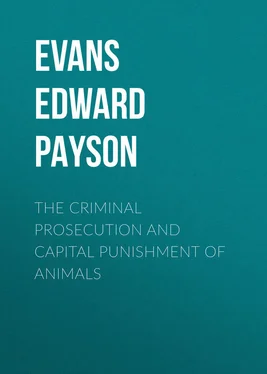Edward Evans - The Criminal Prosecution and Capital Punishment of Animals
Здесь есть возможность читать онлайн «Edward Evans - The Criminal Prosecution and Capital Punishment of Animals» — ознакомительный отрывок электронной книги совершенно бесплатно, а после прочтения отрывка купить полную версию. В некоторых случаях можно слушать аудио, скачать через торрент в формате fb2 и присутствует краткое содержание. Жанр: foreign_antique, foreign_prose, на английском языке. Описание произведения, (предисловие) а так же отзывы посетителей доступны на портале библиотеки ЛибКат.
- Название:The Criminal Prosecution and Capital Punishment of Animals
- Автор:
- Жанр:
- Год:неизвестен
- ISBN:нет данных
- Рейтинг книги:5 / 5. Голосов: 1
-
Избранное:Добавить в избранное
- Отзывы:
-
Ваша оценка:
- 100
- 1
- 2
- 3
- 4
- 5
The Criminal Prosecution and Capital Punishment of Animals: краткое содержание, описание и аннотация
Предлагаем к чтению аннотацию, описание, краткое содержание или предисловие (зависит от того, что написал сам автор книги «The Criminal Prosecution and Capital Punishment of Animals»). Если вы не нашли необходимую информацию о книге — напишите в комментариях, мы постараемся отыскать её.
The Criminal Prosecution and Capital Punishment of Animals — читать онлайн ознакомительный отрывок
Ниже представлен текст книги, разбитый по страницам. Система сохранения места последней прочитанной страницы, позволяет с удобством читать онлайн бесплатно книгу «The Criminal Prosecution and Capital Punishment of Animals», без необходимости каждый раз заново искать на чём Вы остановились. Поставьте закладку, и сможете в любой момент перейти на страницу, на которой закончили чтение.
Интервал:
Закладка:
Edmund P. Evans
The Criminal Prosecution and Capital Punishment of Animals
INTRODUCTION
The present volume is the result of the revision and expansion of two essays entitled “Bugs and Beasts before the Law,” and “Modern and Mediæval Punishment,” which appeared in The Atlantic Monthly , in August and September 1884. Since that date the author has collected a vast amount of additional material on the subject, which has also been discussed by other writers in several publications, the most noteworthy of which are Professor Karl von Amira’s Thierstrafen und Thierprocesse (Innsbruck, 1891), Carlo d’Addosio’s Bestie Delinquenti (Napoli, 1892), and G. Tobler’s Thierprocesse in der Schweiz (Bern, 1893), but in none of these works, except the first-mentioned, are there any important statements of facts or citations of cases in addition to those adduced in the essays already mentioned, for which the writer was indebted chiefly to the extensive and exceedingly valuable researches of Berriat-Saint-Prix and M. L. Ménebréa, and the Consilium Primum of Bartholomew Chassenée, cited in the appended bibliography. Professor Von Amira is a very distinguished and remarkably keen-sighted jurisprudent and treats the matter exclusively from a jurisprudential point of view, his main object being to discover some general principle on which to explain these strange phenomena, and thus to assign to them their proper place and true significance in the historical evolution of the idea of justice and the methods of attaining it by legal procedure.
Von Amira draws a sharp line of technical distinction between Thierstrafen and Thierprocesse; the former were capital punishments inflicted by secular tribunals upon pigs, cows, horses, and other domestic animals as a penalty for homicide; the latter were judicial proceedings instituted by ecclesiastical courts against rats, mice, locusts, weevils, and other vermin in order to prevent them from devouring the crops, and to expel them from orchards, vineyards, and cultivated fields by means of exorcism and excommunication. Animals, which were in the service of man, could be arrested, tried, convicted and executed, like any other members of his household; it was, therefore, not necessary to summon them to appear in court at a specified time to answer for their conduct, and thus make them, in the strict sense of the term, a party to the prosecution, for the sheriff had already taken them in charge and consigned them to the custody of the jailer. Insects and rodents, on the other hand, which were not subject to human control and could not be seized and imprisoned by the civil authorities, demanded the intervention of the Church and the exercise of its supernatural functions for the purpose of compelling them to desist from their devastations and to retire from all places devoted to the production of human sustenance. The only feasible method of staying the ravages of these swarms of noxious creatures was to resort to “metaphysical aid” and to expel or exterminate them by sacerdotal conjuring and cursing. The fact that it was customary to catch several specimens of the culprits and bring them before the seat of justice, and there solemnly put them to death while the anathema was being pronounced, proves that this summary manner of dealing would have been applied to the whole of them, had it been possible to do so. Indeed, the attempt was sometimes made to get rid of them by setting a price on their heads, as was the case with the plague of locusts at Rome in 880, when a reward was offered for their extermination, but all efforts in this direction proving futile, on account of the rapidity with which they propagated, recourse was had to exorcisms and be-sprinklings with holy water.
D’Addosio speaks of the actions brought against domestic animals for homicide as penal prosecutions, and those instituted against insects and vermin for injury done to the fruits of the field as civil suits ( processi civili ); but the latter designation is not correct in any proper sense of the term, since these actions were not suits to recover for damages to property, but had solely a preventive or prohibitive character. The judicial process was preliminary to the utterance of the malediction and essential to its efficacy. Before fulminating an excommunication the whole machinery of justice was put in motion in order to establish the guilt of the accused, who were then warned, admonished, and threatened, and, in cases of obduracy, smitten with the anathema maranatha and devoted to utter destruction. As with all bans, charms, exorcisms, incantations, and other magical hocus-pocus, the omission of any formality would vitiate the whole procedure, and, by breaking the spell, deprive the imprecation or interdiction of its occult virtue. Ecclesiastical thunder would thus be robbed of its fatal bolt and reduced to mere empty noise, the harmless explosion of a blank cartridge.
The Church was not wholly consistent in its explanations of these phenomena. In general the swarms of devouring insects and other noxious vermin are assumed to have been sent at the instigation of Satan ( instigante sathana, per maleficium diabolicum ), and are denounced and deprecated as snares of the devil and his satellites ( diaboli et ministrorum insidias ); again they are treated as creatures of God and agents of the Almighty for the punishment of sinful man; from this latter point of view every effort to exterminate them by natural means would be regarded as a sort of sacrilege, an impious attempt to war upon the Supreme Being and to withstand His designs. In either case, whether they were the emissaries of a wicked demon or of a wrathful Deity, the only proper and permissible way of relief was through the offices of the Church, whose bishops and other clergy were empowered to perform the adjurations and maledictions or to prescribe the penances and propitiations necessary to produce this result. If the insects were instruments of the devil, they might be driven into the sea or banished to some arid region, where they would all miserably perish; if, on the other hand, they were recognized as the ministers of God, divinely delegated to scourge mankind for the promotion of piety, it would be suitable, after they had fulfilled their mission, to cause them to withdraw from the cultivated fields and to assign them a spot, where they might live in comfort without injury to the inhabitants. The records contain instances of both kinds of treatment.
It was also as a protection against evil spirits that the penalty of death was inflicted upon domestic animals. A homicidal pig or bull was not necessarily assumed to be the incarnation of a demon, although it was maintained by eminent authorities, as we have shown in the present work, that all beasts and birds, as well as creeping things, were devils in disguise; but the homicide, if it were permitted to go unpunished, was supposed to furnish occasion for the intervention of devils, who were thereby enabled to take possession of both persons and places. This belief was prevalent in the Middle Ages, and is still taught by the Catholic Church. In a little volume entitled Die Verwaltung des Exorcistats nach Massgabe der römischen Benediktionale , of which a revised and enlarged edition was published at Stuttgart in 1893 for the use of priests as a manual of instruction in performing exorcisms, it is expressly stated by the reverend author, Dr. Theobald Bischofberger, that a spot, where a murder or other heinous crime has been committed, if the said crime remains undetected or unexpiated, is sure to be infested by demons, and that the inmates of a house or other building erected upon such a site will be peculiarly liable to diabolical possession, however innocent they may be personally.
Читать дальшеИнтервал:
Закладка:
Похожие книги на «The Criminal Prosecution and Capital Punishment of Animals»
Представляем Вашему вниманию похожие книги на «The Criminal Prosecution and Capital Punishment of Animals» списком для выбора. Мы отобрали схожую по названию и смыслу литературу в надежде предоставить читателям больше вариантов отыскать новые, интересные, ещё непрочитанные произведения.
Обсуждение, отзывы о книге «The Criminal Prosecution and Capital Punishment of Animals» и просто собственные мнения читателей. Оставьте ваши комментарии, напишите, что Вы думаете о произведении, его смысле или главных героях. Укажите что конкретно понравилось, а что нет, и почему Вы так считаете.












